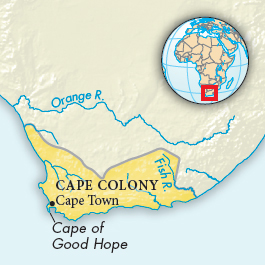Understanding World Societies:
Printed Page 596
The Institution of Slavery in Africa

The prints and cartoons of Thomas Rowlandson (1756–
Islamic practices strongly influenced African slavery. African rulers justified enslavement with the Muslim argument that prisoners of war could be sold and that captured people were considered chattel. Between 650 and 1600 Muslims transported perhaps as many as 4.82 million black slaves across the trans-
Meanwhile, the flow of black people to Europe, begun during the Renaissance, continued. In the seventeenth and eighteenth centuries as many as two hundred thousand Africans entered European societies. Some arrived as slaves, others as servants; the legal distinction was not always clear. Eighteenth-

In 1658 the Dutch East India Company (see “The Birth of the Global Economy” in Chapter 16) began to allow the importation of slaves into the Cape Colony, which the company had founded on the southern tip of Africa in 1652. Over the next century and a half about 75 percent of the slaves brought into the colony came from Dutch East India Company colonies in India and Southeast Asia or from Madagascar; the remaining 25 percent came from Africa. Most worked long and hard as field hands and at any other menial or manual forms of labor needed by their European masters. The Dutch East India Company was the single largest slave owner in the Cape Colony, employing its slaves on public works and company farms.
Although in the seventeenth and eighteenth centuries Holland enjoyed a Europe-
The slave trade expanded greatly in East Africa’s savanna and Horn regions in the late eighteenth century and the first half of the nineteenth century. Why this increased demand? Merchants and planters wanted slaves to work the sugar plantations on the Mascarene Islands, located east of Madagascar; the clove plantations on Zanzibar and Pemba; and the food plantations along the Kenyan coast. The eastern coast also exported enslaved people to the Americas, particularly to Brazil. In the late eighteenth and early nineteenth centuries, precisely when the slave trade to North America and the Caribbean declined, the Arabian and Asian markets expanded.